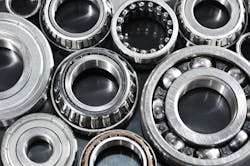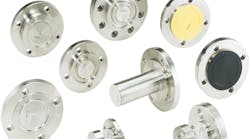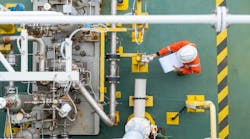The following Q&A is provided by the Hydraulic Institute (HI), a leading developer of pump standards, technical reports and guidelines, data books, and educational material. As an ANSI-accredited standards developer, the Hydraulic Institute continuously reviews and updates its pump standards and adds new subjects as requested by the pump community. The organization encourages users to submit questions, and HI will respond based on existing HI standards, technical documents, and educational products. Please direct your inquires to [email protected].
Q: How can we get longer life from the ball bearings in our pump? Our process uses an end-suction centrifugal pump to circulate heat transfer liquid at 750 F. The bearing housing is cooled, and the bearings look clean after they fail. What else should we look for?
A: Pump bearings are most likely to fail due to contamination and poor lubrication. However, that does not seem to be the case since the bearings are clean. In addition, the bearing cooling is a big help.
That leaves the matter of excess bearing load. This is also consistent with the regularity of the failures.
One common cause of high bearing load is coupling misalignment. If the coupling halves are aligned when the pump is cold, they will usually move out of alignment as the pump heats up. Even with the pump supports at the shaft centerline, some movement from pipe stains is still possible. To avoid this problem, shut down the pump when it reaches operating temperature and recheck the coupling alignment. Realign the coupling if necessary.
Another cause of high bearing load is operation below 50 percent of the pump”s best efficiency rate of flow. At low flowrates, all of the flow from the impeller cannot exit from the pump casing so it recirculates in the impeller. This causes an uneven distribution of pressure around the impeller resulting in a high radial force on the impeller, which must be supported by the bearings. To guard against this, determine the actual rate of flow through the pump and make sure it is close to the pump”s best efficiency flow.
Another problem, which is unique to high-temperature applications, is excessive expansion on the bearing inner race. Even with bearing cooling, heat is transmitted to the bearing through the pump shaft. This heat causes the shaft diameter and the inner raceway of the bearing to expand, which in turn squeezes the rotating balls in the bearing. The result is shorter bearing life, which can be corrected by using bearings with greater internal clearance. Such bearings may also be referred to as C3 Fit bearings.
Q: Nonmetallic materials such as Noryl and Teflon have excellent corrosion resistance and should be good for pump components. However, they probably have limitations due to tensile strength and temperature. If so, what are these limits?
A: Nonmetallic materials or polymers are frequently used in pump construction. Thermoplastic materials are usually injection molded and are usually limited to 200 F and pressure containment below 250 PSI and seldom used for rates of flow above 1000 GPM.
Thermoset materials are a little better with limits up to 250 F and pressures up to 250 PSI. They can be found in pumps up to 4000 GPM.
The temperature limit is also dependent on the liquid being pumped. Data from the producers of eleven different polymers has been collected by the Hydraulic Institute and published in a table with 150 different liquids. This table can be found in ANSI/HI 9.1-9.5 Pumps – General Guidelines.
Q: I have been told that centrifugal pumps handling hydrocarbon liquids can operate safely with less NPSH Available than the NPSH Required by the pump rating curve. Is this true? If so, how much reduction in the NPSHR can be allowed?
A: Yes. The NPSH (net positive suction head) requirements of centrifugal pumps are normally determined on the basis of handling water at or near normal room temperature. Operating experience in the field has indicated, and a limited number of carefully controlled laboratory tests have confirmed, that pumps handling certain hydrocarbon liquids, or water at significantly higher than room temperatures, will operate satisfactorily with less NPSH available than would be required for cold water.
The thermodynamic properties of boiling liquids at high vapor pressures are such that the vapors produce fewer blockages between the impeller vanes and less reduction in head produced by the impeller. The following table is an approximate guide to how much NPSHR can be reduced as a function of vapor pressure and fluid temperature. For more detailed and accurate information, see Section 1.3.4.1.16.3 (Fig 1.69A & B) in ANSI/HI 1.3 Centrifugal Pumps for Design and Applications.
|
Liquid Vapor Pressure, PSIA 80
40 20 10 |
NPSHR Reduction, Feet 10 5
2 1 |


